Analysis of a Medical Curriculum Case Scenario Report - University
VerifiedAdded on 2020/05/28
|10
|2497
|190
Report
AI Summary
This report analyzes a case scenario related to a medical curriculum, focusing on outcome-based education and various teaching methodologies. The report examines the integrated curriculum model versus the traditional model, highlighting the importance of learner-centered approaches. It delves into the benefits of small group teaching, discussing how it enhances interaction, critical thinking, and intercultural exchange among students. The analysis also addresses challenges faced by learners and proposes solutions like tutor performance reviews, mentoring, peer observations, and one-to-one meetings to improve teaching practices and student outcomes. The report also explores relevant curriculum theories, particularly the process-oriented theory, emphasizing its applicability to the case. The references provided offer a comprehensive overview of the research on the subjects discussed in the report.
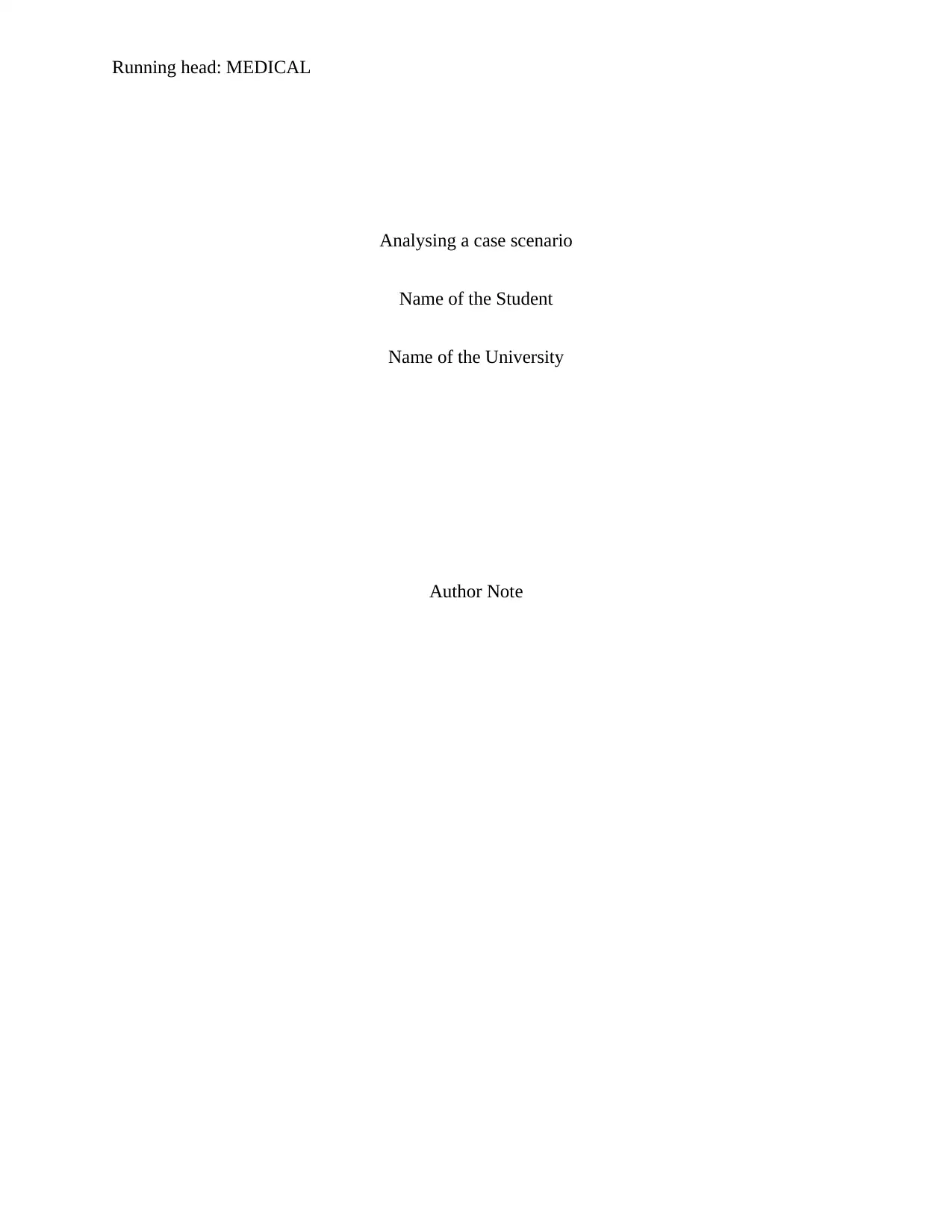
Running head: MEDICAL
Analysing a case scenario
Name of the Student
Name of the University
Author Note
Analysing a case scenario
Name of the Student
Name of the University
Author Note
Paraphrase This Document
Need a fresh take? Get an instant paraphrase of this document with our AI Paraphraser
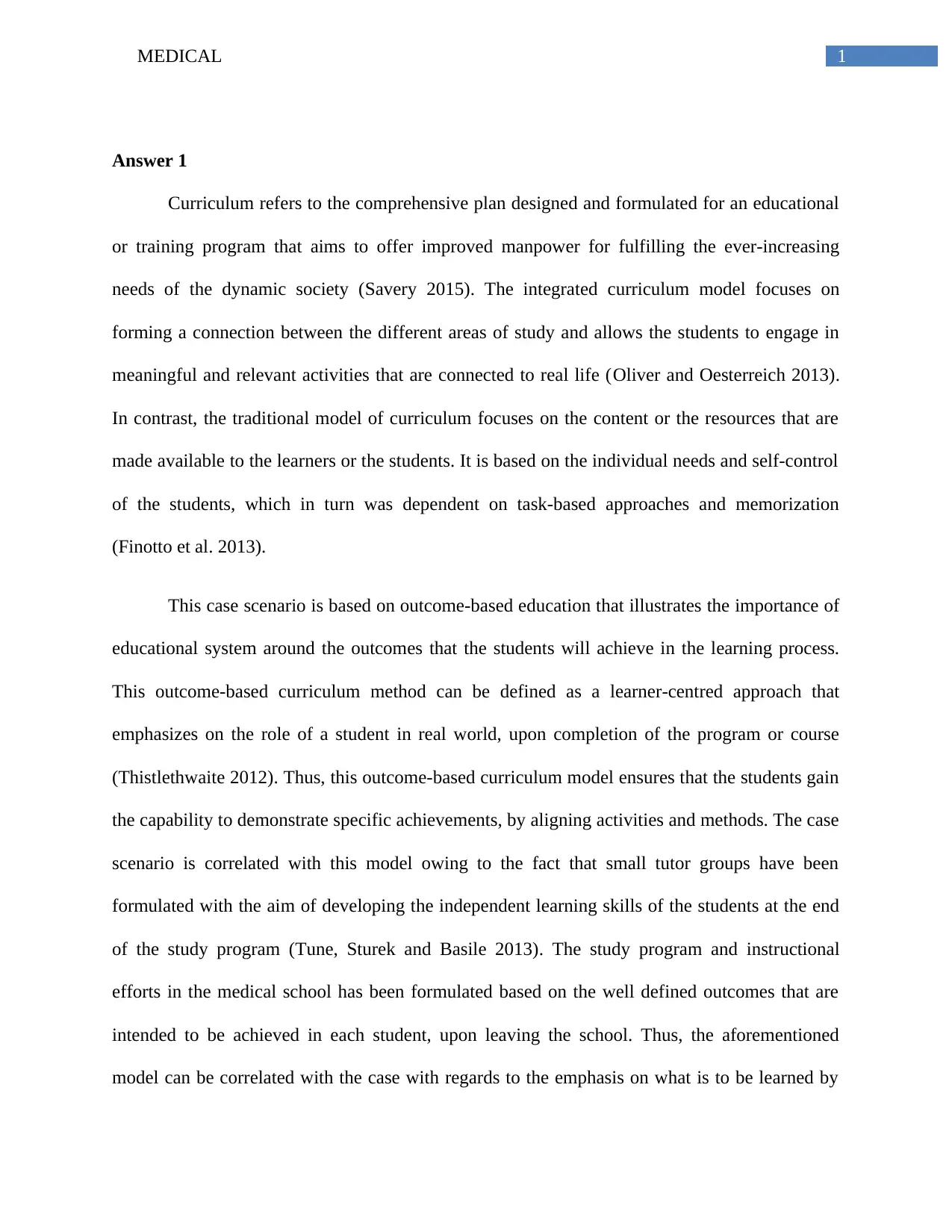
1MEDICAL
Answer 1
Curriculum refers to the comprehensive plan designed and formulated for an educational
or training program that aims to offer improved manpower for fulfilling the ever-increasing
needs of the dynamic society (Savery 2015). The integrated curriculum model focuses on
forming a connection between the different areas of study and allows the students to engage in
meaningful and relevant activities that are connected to real life (Oliver and Oesterreich 2013).
In contrast, the traditional model of curriculum focuses on the content or the resources that are
made available to the learners or the students. It is based on the individual needs and self-control
of the students, which in turn was dependent on task-based approaches and memorization
(Finotto et al. 2013).
This case scenario is based on outcome-based education that illustrates the importance of
educational system around the outcomes that the students will achieve in the learning process.
This outcome-based curriculum method can be defined as a learner-centred approach that
emphasizes on the role of a student in real world, upon completion of the program or course
(Thistlethwaite 2012). Thus, this outcome-based curriculum model ensures that the students gain
the capability to demonstrate specific achievements, by aligning activities and methods. The case
scenario is correlated with this model owing to the fact that small tutor groups have been
formulated with the aim of developing the independent learning skills of the students at the end
of the study program (Tune, Sturek and Basile 2013). The study program and instructional
efforts in the medical school has been formulated based on the well defined outcomes that are
intended to be achieved in each student, upon leaving the school. Thus, the aforementioned
model can be correlated with the case with regards to the emphasis on what is to be learned by
Answer 1
Curriculum refers to the comprehensive plan designed and formulated for an educational
or training program that aims to offer improved manpower for fulfilling the ever-increasing
needs of the dynamic society (Savery 2015). The integrated curriculum model focuses on
forming a connection between the different areas of study and allows the students to engage in
meaningful and relevant activities that are connected to real life (Oliver and Oesterreich 2013).
In contrast, the traditional model of curriculum focuses on the content or the resources that are
made available to the learners or the students. It is based on the individual needs and self-control
of the students, which in turn was dependent on task-based approaches and memorization
(Finotto et al. 2013).
This case scenario is based on outcome-based education that illustrates the importance of
educational system around the outcomes that the students will achieve in the learning process.
This outcome-based curriculum method can be defined as a learner-centred approach that
emphasizes on the role of a student in real world, upon completion of the program or course
(Thistlethwaite 2012). Thus, this outcome-based curriculum model ensures that the students gain
the capability to demonstrate specific achievements, by aligning activities and methods. The case
scenario is correlated with this model owing to the fact that small tutor groups have been
formulated with the aim of developing the independent learning skills of the students at the end
of the study program (Tune, Sturek and Basile 2013). The study program and instructional
efforts in the medical school has been formulated based on the well defined outcomes that are
intended to be achieved in each student, upon leaving the school. Thus, the aforementioned
model can be correlated with the case with regards to the emphasis on what is to be learned by

2MEDICAL
the students. In this context, a demonstration of learning at the end of the learning experience is
the primary outcome, based on which the model has been formulated (Morcke, Dornan and Eika
2013).
Curriculum theories are sets of educational concepts that afford an illuminating and
systematic perspective of the curricula (Pinar 2012). While there are several structure-oriented or
value-oriented theories that are concerned with analysis of the curriculum components and their
interrelationship, and the assumptions and values of the curriculum makers, the process-oriented
theory seems to apply in this context (Renkl 2014). This theory is primarily concerned with
providing a description of development of curricula and its recommendations (Barth 2013). This
theory enhances the decision making skills and capabilities of the learners. Thus, it seems
relevant for this case as it focuses on the processes and skills that are involved in learning (Chen,
Chen and Chen 2014).
Answer 2 (a)
The case scenario involves teaching students in small groups that helps in providing the
learners with the opportunity that makes them more interactive than in group lectures.
Furthermore, it facilitates cross-cultural exchanges between the educator and the learners. The
outcomes that are intended to be achieved are the following:
Learners will be encouraged to clarify their ideas- A common concern that arises during
large group discussions is related to the reluctance among students to speak. Thus, it
becomes difficult to empathise with individual students in a class. Teaching a limited
number of students in a small group will help in initiating interaction by eliminating
the students. In this context, a demonstration of learning at the end of the learning experience is
the primary outcome, based on which the model has been formulated (Morcke, Dornan and Eika
2013).
Curriculum theories are sets of educational concepts that afford an illuminating and
systematic perspective of the curricula (Pinar 2012). While there are several structure-oriented or
value-oriented theories that are concerned with analysis of the curriculum components and their
interrelationship, and the assumptions and values of the curriculum makers, the process-oriented
theory seems to apply in this context (Renkl 2014). This theory is primarily concerned with
providing a description of development of curricula and its recommendations (Barth 2013). This
theory enhances the decision making skills and capabilities of the learners. Thus, it seems
relevant for this case as it focuses on the processes and skills that are involved in learning (Chen,
Chen and Chen 2014).
Answer 2 (a)
The case scenario involves teaching students in small groups that helps in providing the
learners with the opportunity that makes them more interactive than in group lectures.
Furthermore, it facilitates cross-cultural exchanges between the educator and the learners. The
outcomes that are intended to be achieved are the following:
Learners will be encouraged to clarify their ideas- A common concern that arises during
large group discussions is related to the reluctance among students to speak. Thus, it
becomes difficult to empathise with individual students in a class. Teaching a limited
number of students in a small group will help in initiating interaction by eliminating
⊘ This is a preview!⊘
Do you want full access?
Subscribe today to unlock all pages.

Trusted by 1+ million students worldwide
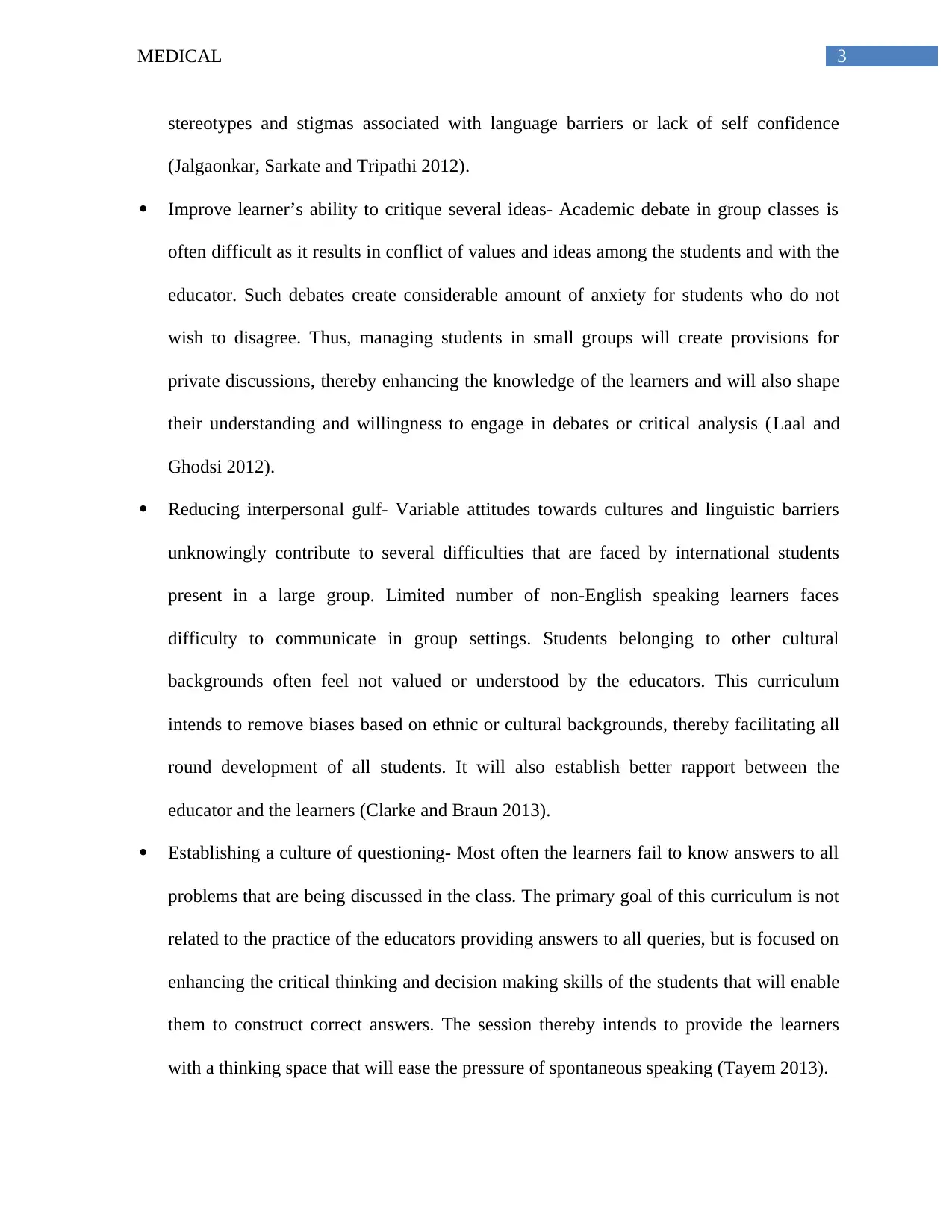
3MEDICAL
stereotypes and stigmas associated with language barriers or lack of self confidence
(Jalgaonkar, Sarkate and Tripathi 2012).
Improve learner’s ability to critique several ideas- Academic debate in group classes is
often difficult as it results in conflict of values and ideas among the students and with the
educator. Such debates create considerable amount of anxiety for students who do not
wish to disagree. Thus, managing students in small groups will create provisions for
private discussions, thereby enhancing the knowledge of the learners and will also shape
their understanding and willingness to engage in debates or critical analysis (Laal and
Ghodsi 2012).
Reducing interpersonal gulf- Variable attitudes towards cultures and linguistic barriers
unknowingly contribute to several difficulties that are faced by international students
present in a large group. Limited number of non-English speaking learners faces
difficulty to communicate in group settings. Students belonging to other cultural
backgrounds often feel not valued or understood by the educators. This curriculum
intends to remove biases based on ethnic or cultural backgrounds, thereby facilitating all
round development of all students. It will also establish better rapport between the
educator and the learners (Clarke and Braun 2013).
Establishing a culture of questioning- Most often the learners fail to know answers to all
problems that are being discussed in the class. The primary goal of this curriculum is not
related to the practice of the educators providing answers to all queries, but is focused on
enhancing the critical thinking and decision making skills of the students that will enable
them to construct correct answers. The session thereby intends to provide the learners
with a thinking space that will ease the pressure of spontaneous speaking (Tayem 2013).
stereotypes and stigmas associated with language barriers or lack of self confidence
(Jalgaonkar, Sarkate and Tripathi 2012).
Improve learner’s ability to critique several ideas- Academic debate in group classes is
often difficult as it results in conflict of values and ideas among the students and with the
educator. Such debates create considerable amount of anxiety for students who do not
wish to disagree. Thus, managing students in small groups will create provisions for
private discussions, thereby enhancing the knowledge of the learners and will also shape
their understanding and willingness to engage in debates or critical analysis (Laal and
Ghodsi 2012).
Reducing interpersonal gulf- Variable attitudes towards cultures and linguistic barriers
unknowingly contribute to several difficulties that are faced by international students
present in a large group. Limited number of non-English speaking learners faces
difficulty to communicate in group settings. Students belonging to other cultural
backgrounds often feel not valued or understood by the educators. This curriculum
intends to remove biases based on ethnic or cultural backgrounds, thereby facilitating all
round development of all students. It will also establish better rapport between the
educator and the learners (Clarke and Braun 2013).
Establishing a culture of questioning- Most often the learners fail to know answers to all
problems that are being discussed in the class. The primary goal of this curriculum is not
related to the practice of the educators providing answers to all queries, but is focused on
enhancing the critical thinking and decision making skills of the students that will enable
them to construct correct answers. The session thereby intends to provide the learners
with a thinking space that will ease the pressure of spontaneous speaking (Tayem 2013).
Paraphrase This Document
Need a fresh take? Get an instant paraphrase of this document with our AI Paraphraser
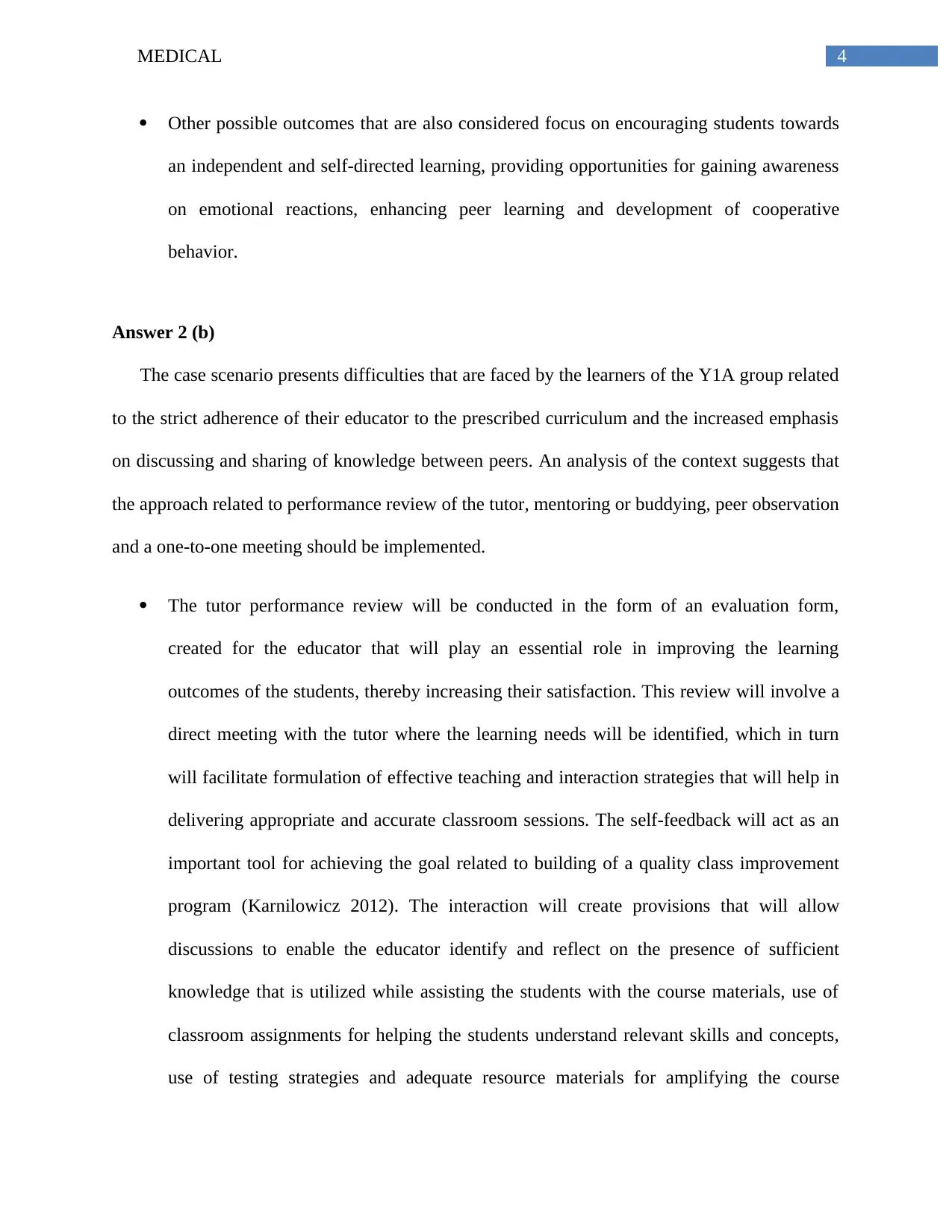
4MEDICAL
Other possible outcomes that are also considered focus on encouraging students towards
an independent and self-directed learning, providing opportunities for gaining awareness
on emotional reactions, enhancing peer learning and development of cooperative
behavior.
Answer 2 (b)
The case scenario presents difficulties that are faced by the learners of the Y1A group related
to the strict adherence of their educator to the prescribed curriculum and the increased emphasis
on discussing and sharing of knowledge between peers. An analysis of the context suggests that
the approach related to performance review of the tutor, mentoring or buddying, peer observation
and a one-to-one meeting should be implemented.
The tutor performance review will be conducted in the form of an evaluation form,
created for the educator that will play an essential role in improving the learning
outcomes of the students, thereby increasing their satisfaction. This review will involve a
direct meeting with the tutor where the learning needs will be identified, which in turn
will facilitate formulation of effective teaching and interaction strategies that will help in
delivering appropriate and accurate classroom sessions. The self-feedback will act as an
important tool for achieving the goal related to building of a quality class improvement
program (Karnilowicz 2012). The interaction will create provisions that will allow
discussions to enable the educator identify and reflect on the presence of sufficient
knowledge that is utilized while assisting the students with the course materials, use of
classroom assignments for helping the students understand relevant skills and concepts,
use of testing strategies and adequate resource materials for amplifying the course
Other possible outcomes that are also considered focus on encouraging students towards
an independent and self-directed learning, providing opportunities for gaining awareness
on emotional reactions, enhancing peer learning and development of cooperative
behavior.
Answer 2 (b)
The case scenario presents difficulties that are faced by the learners of the Y1A group related
to the strict adherence of their educator to the prescribed curriculum and the increased emphasis
on discussing and sharing of knowledge between peers. An analysis of the context suggests that
the approach related to performance review of the tutor, mentoring or buddying, peer observation
and a one-to-one meeting should be implemented.
The tutor performance review will be conducted in the form of an evaluation form,
created for the educator that will play an essential role in improving the learning
outcomes of the students, thereby increasing their satisfaction. This review will involve a
direct meeting with the tutor where the learning needs will be identified, which in turn
will facilitate formulation of effective teaching and interaction strategies that will help in
delivering appropriate and accurate classroom sessions. The self-feedback will act as an
important tool for achieving the goal related to building of a quality class improvement
program (Karnilowicz 2012). The interaction will create provisions that will allow
discussions to enable the educator identify and reflect on the presence of sufficient
knowledge that is utilized while assisting the students with the course materials, use of
classroom assignments for helping the students understand relevant skills and concepts,
use of testing strategies and adequate resource materials for amplifying the course
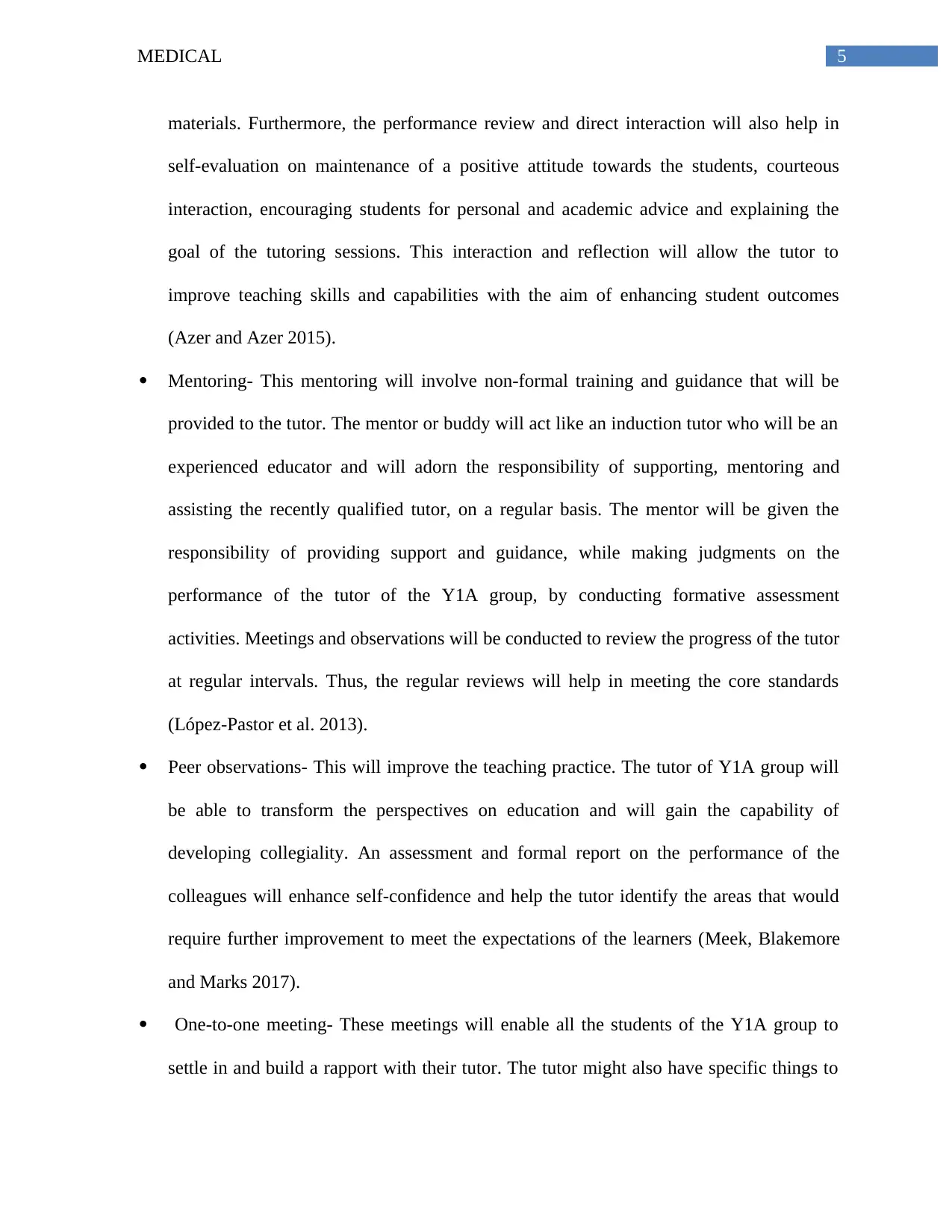
5MEDICAL
materials. Furthermore, the performance review and direct interaction will also help in
self-evaluation on maintenance of a positive attitude towards the students, courteous
interaction, encouraging students for personal and academic advice and explaining the
goal of the tutoring sessions. This interaction and reflection will allow the tutor to
improve teaching skills and capabilities with the aim of enhancing student outcomes
(Azer and Azer 2015).
Mentoring- This mentoring will involve non-formal training and guidance that will be
provided to the tutor. The mentor or buddy will act like an induction tutor who will be an
experienced educator and will adorn the responsibility of supporting, mentoring and
assisting the recently qualified tutor, on a regular basis. The mentor will be given the
responsibility of providing support and guidance, while making judgments on the
performance of the tutor of the Y1A group, by conducting formative assessment
activities. Meetings and observations will be conducted to review the progress of the tutor
at regular intervals. Thus, the regular reviews will help in meeting the core standards
(López-Pastor et al. 2013).
Peer observations- This will improve the teaching practice. The tutor of Y1A group will
be able to transform the perspectives on education and will gain the capability of
developing collegiality. An assessment and formal report on the performance of the
colleagues will enhance self-confidence and help the tutor identify the areas that would
require further improvement to meet the expectations of the learners (Meek, Blakemore
and Marks 2017).
One-to-one meeting- These meetings will enable all the students of the Y1A group to
settle in and build a rapport with their tutor. The tutor might also have specific things to
materials. Furthermore, the performance review and direct interaction will also help in
self-evaluation on maintenance of a positive attitude towards the students, courteous
interaction, encouraging students for personal and academic advice and explaining the
goal of the tutoring sessions. This interaction and reflection will allow the tutor to
improve teaching skills and capabilities with the aim of enhancing student outcomes
(Azer and Azer 2015).
Mentoring- This mentoring will involve non-formal training and guidance that will be
provided to the tutor. The mentor or buddy will act like an induction tutor who will be an
experienced educator and will adorn the responsibility of supporting, mentoring and
assisting the recently qualified tutor, on a regular basis. The mentor will be given the
responsibility of providing support and guidance, while making judgments on the
performance of the tutor of the Y1A group, by conducting formative assessment
activities. Meetings and observations will be conducted to review the progress of the tutor
at regular intervals. Thus, the regular reviews will help in meeting the core standards
(López-Pastor et al. 2013).
Peer observations- This will improve the teaching practice. The tutor of Y1A group will
be able to transform the perspectives on education and will gain the capability of
developing collegiality. An assessment and formal report on the performance of the
colleagues will enhance self-confidence and help the tutor identify the areas that would
require further improvement to meet the expectations of the learners (Meek, Blakemore
and Marks 2017).
One-to-one meeting- These meetings will enable all the students of the Y1A group to
settle in and build a rapport with their tutor. The tutor might also have specific things to
⊘ This is a preview!⊘
Do you want full access?
Subscribe today to unlock all pages.

Trusted by 1+ million students worldwide

6MEDICAL
share and discuss about the students, which in turn will facilitate sharing of concerns and
queries. These meetings will facilitate academic progress and future directions. It will
also assist the students to let the tutor know of their individual concerns related to the
classroom sessions. Thus, the meetings will help in clarifying concepts and ideas. It will
assist the tutor to reassure the students in a welcoming way, thereby demonstrating that
all possible efforts shall be taken to support them. Thus, the meetings will put the
students at ease and will help the tutor identify the aspects that need increased attention
(Karnilowicz 2012).
However, there are certain approaches that will not be selected in this context. Sending an
e-mail brief to all the tutor groups will make all students regardless of their group know
about the problems that the concerned learners are facing in their classroom sessions. This
would in turn create an embarrassing situation for the tutor. Professional training event for
the group is not a feasible option since the main difficulty is related to the classroom teaching
skills that are implemented in the group. Similarly, meeting with the whole group to discuss
the issue might result in conflicts among the students due to differences in their opinions
regarding the tutor (Kilian, Hofer and Kuhnle 2013).
share and discuss about the students, which in turn will facilitate sharing of concerns and
queries. These meetings will facilitate academic progress and future directions. It will
also assist the students to let the tutor know of their individual concerns related to the
classroom sessions. Thus, the meetings will help in clarifying concepts and ideas. It will
assist the tutor to reassure the students in a welcoming way, thereby demonstrating that
all possible efforts shall be taken to support them. Thus, the meetings will put the
students at ease and will help the tutor identify the aspects that need increased attention
(Karnilowicz 2012).
However, there are certain approaches that will not be selected in this context. Sending an
e-mail brief to all the tutor groups will make all students regardless of their group know
about the problems that the concerned learners are facing in their classroom sessions. This
would in turn create an embarrassing situation for the tutor. Professional training event for
the group is not a feasible option since the main difficulty is related to the classroom teaching
skills that are implemented in the group. Similarly, meeting with the whole group to discuss
the issue might result in conflicts among the students due to differences in their opinions
regarding the tutor (Kilian, Hofer and Kuhnle 2013).
Paraphrase This Document
Need a fresh take? Get an instant paraphrase of this document with our AI Paraphraser
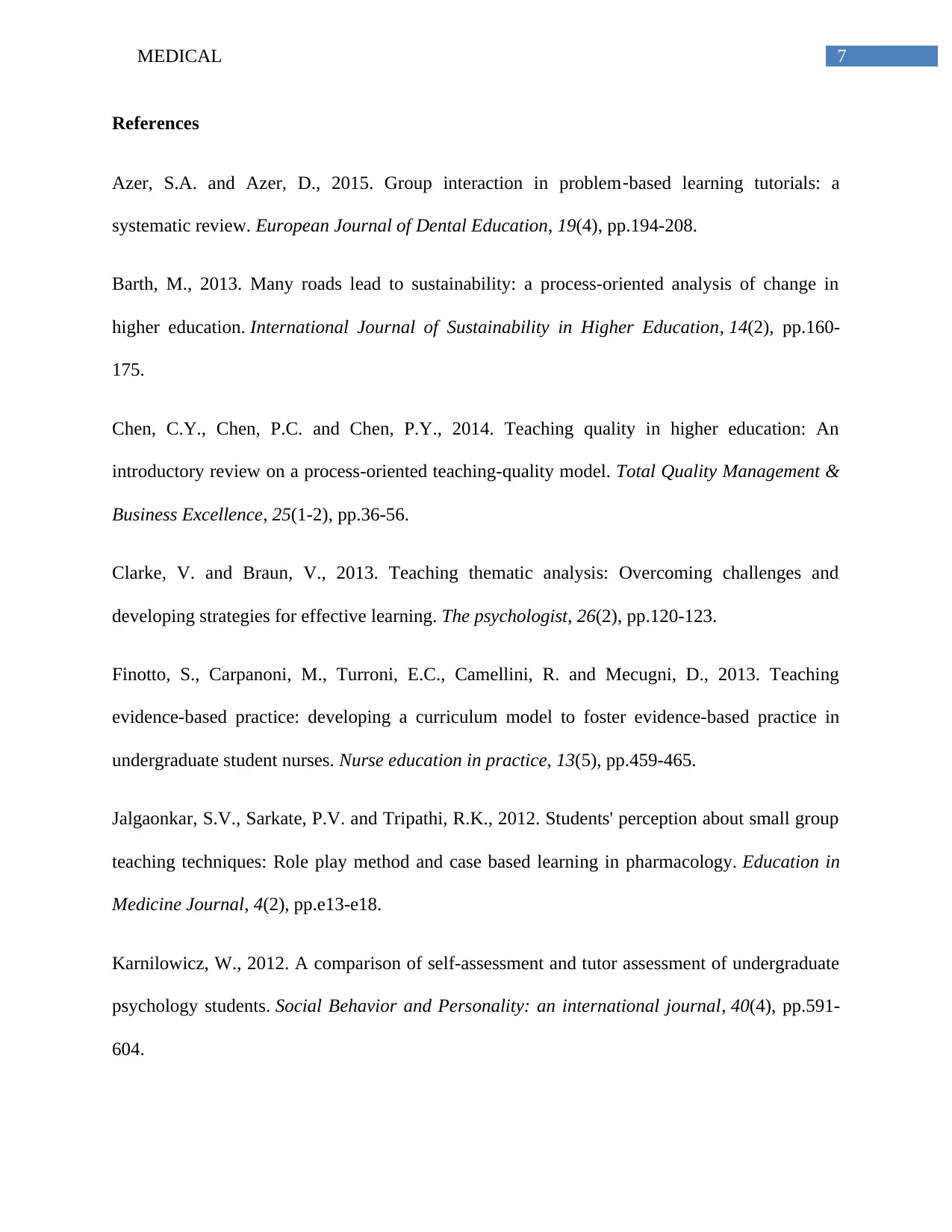
7MEDICAL
References
Azer, S.A. and Azer, D., 2015. Group interaction in problem‐based learning tutorials: a
systematic review. European Journal of Dental Education, 19(4), pp.194-208.
Barth, M., 2013. Many roads lead to sustainability: a process-oriented analysis of change in
higher education. International Journal of Sustainability in Higher Education, 14(2), pp.160-
175.
Chen, C.Y., Chen, P.C. and Chen, P.Y., 2014. Teaching quality in higher education: An
introductory review on a process-oriented teaching-quality model. Total Quality Management &
Business Excellence, 25(1-2), pp.36-56.
Clarke, V. and Braun, V., 2013. Teaching thematic analysis: Overcoming challenges and
developing strategies for effective learning. The psychologist, 26(2), pp.120-123.
Finotto, S., Carpanoni, M., Turroni, E.C., Camellini, R. and Mecugni, D., 2013. Teaching
evidence-based practice: developing a curriculum model to foster evidence-based practice in
undergraduate student nurses. Nurse education in practice, 13(5), pp.459-465.
Jalgaonkar, S.V., Sarkate, P.V. and Tripathi, R.K., 2012. Students' perception about small group
teaching techniques: Role play method and case based learning in pharmacology. Education in
Medicine Journal, 4(2), pp.e13-e18.
Karnilowicz, W., 2012. A comparison of self-assessment and tutor assessment of undergraduate
psychology students. Social Behavior and Personality: an international journal, 40(4), pp.591-
604.
References
Azer, S.A. and Azer, D., 2015. Group interaction in problem‐based learning tutorials: a
systematic review. European Journal of Dental Education, 19(4), pp.194-208.
Barth, M., 2013. Many roads lead to sustainability: a process-oriented analysis of change in
higher education. International Journal of Sustainability in Higher Education, 14(2), pp.160-
175.
Chen, C.Y., Chen, P.C. and Chen, P.Y., 2014. Teaching quality in higher education: An
introductory review on a process-oriented teaching-quality model. Total Quality Management &
Business Excellence, 25(1-2), pp.36-56.
Clarke, V. and Braun, V., 2013. Teaching thematic analysis: Overcoming challenges and
developing strategies for effective learning. The psychologist, 26(2), pp.120-123.
Finotto, S., Carpanoni, M., Turroni, E.C., Camellini, R. and Mecugni, D., 2013. Teaching
evidence-based practice: developing a curriculum model to foster evidence-based practice in
undergraduate student nurses. Nurse education in practice, 13(5), pp.459-465.
Jalgaonkar, S.V., Sarkate, P.V. and Tripathi, R.K., 2012. Students' perception about small group
teaching techniques: Role play method and case based learning in pharmacology. Education in
Medicine Journal, 4(2), pp.e13-e18.
Karnilowicz, W., 2012. A comparison of self-assessment and tutor assessment of undergraduate
psychology students. Social Behavior and Personality: an international journal, 40(4), pp.591-
604.
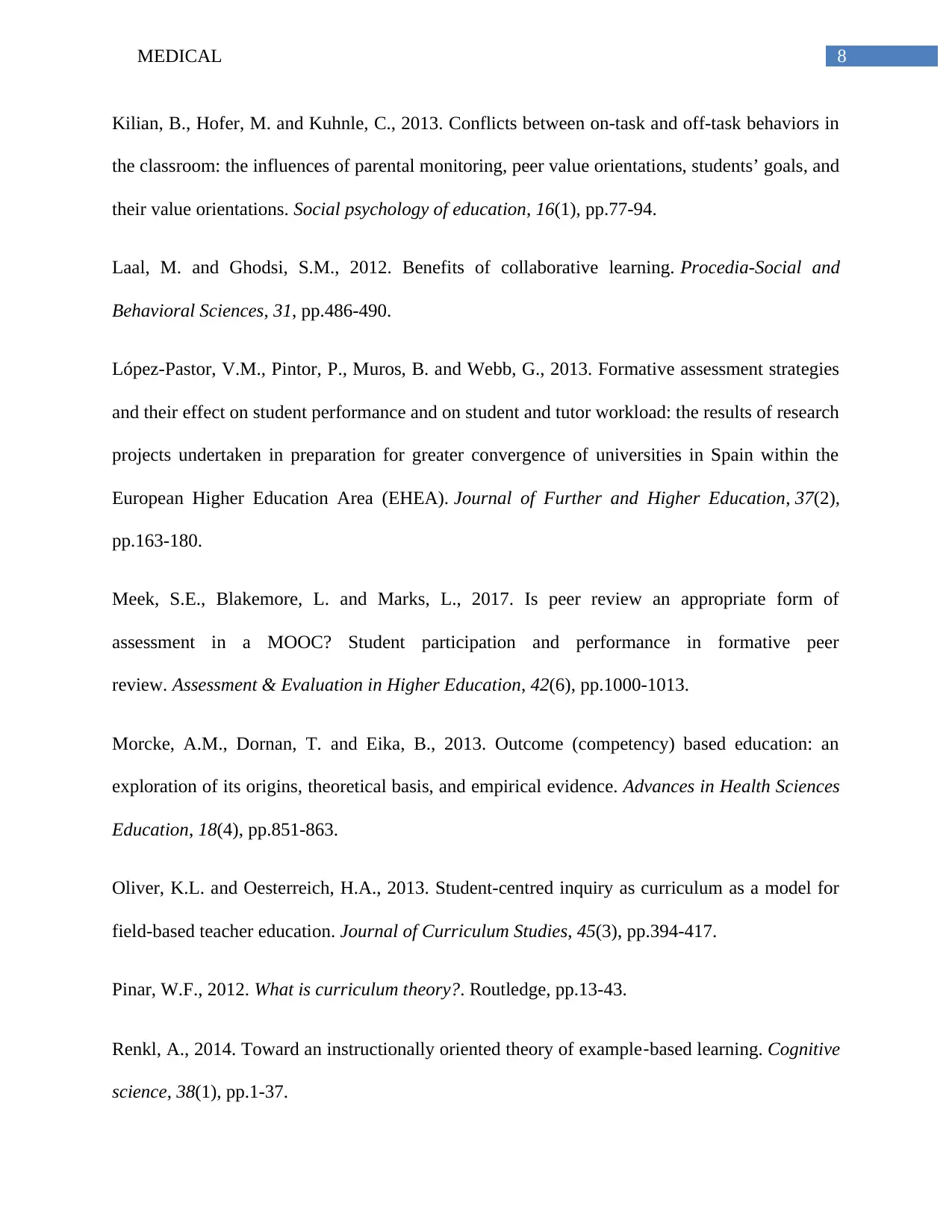
8MEDICAL
Kilian, B., Hofer, M. and Kuhnle, C., 2013. Conflicts between on-task and off-task behaviors in
the classroom: the influences of parental monitoring, peer value orientations, students’ goals, and
their value orientations. Social psychology of education, 16(1), pp.77-94.
Laal, M. and Ghodsi, S.M., 2012. Benefits of collaborative learning. Procedia-Social and
Behavioral Sciences, 31, pp.486-490.
López-Pastor, V.M., Pintor, P., Muros, B. and Webb, G., 2013. Formative assessment strategies
and their effect on student performance and on student and tutor workload: the results of research
projects undertaken in preparation for greater convergence of universities in Spain within the
European Higher Education Area (EHEA). Journal of Further and Higher Education, 37(2),
pp.163-180.
Meek, S.E., Blakemore, L. and Marks, L., 2017. Is peer review an appropriate form of
assessment in a MOOC? Student participation and performance in formative peer
review. Assessment & Evaluation in Higher Education, 42(6), pp.1000-1013.
Morcke, A.M., Dornan, T. and Eika, B., 2013. Outcome (competency) based education: an
exploration of its origins, theoretical basis, and empirical evidence. Advances in Health Sciences
Education, 18(4), pp.851-863.
Oliver, K.L. and Oesterreich, H.A., 2013. Student-centred inquiry as curriculum as a model for
field-based teacher education. Journal of Curriculum Studies, 45(3), pp.394-417.
Pinar, W.F., 2012. What is curriculum theory?. Routledge, pp.13-43.
Renkl, A., 2014. Toward an instructionally oriented theory of example‐based learning. Cognitive
science, 38(1), pp.1-37.
Kilian, B., Hofer, M. and Kuhnle, C., 2013. Conflicts between on-task and off-task behaviors in
the classroom: the influences of parental monitoring, peer value orientations, students’ goals, and
their value orientations. Social psychology of education, 16(1), pp.77-94.
Laal, M. and Ghodsi, S.M., 2012. Benefits of collaborative learning. Procedia-Social and
Behavioral Sciences, 31, pp.486-490.
López-Pastor, V.M., Pintor, P., Muros, B. and Webb, G., 2013. Formative assessment strategies
and their effect on student performance and on student and tutor workload: the results of research
projects undertaken in preparation for greater convergence of universities in Spain within the
European Higher Education Area (EHEA). Journal of Further and Higher Education, 37(2),
pp.163-180.
Meek, S.E., Blakemore, L. and Marks, L., 2017. Is peer review an appropriate form of
assessment in a MOOC? Student participation and performance in formative peer
review. Assessment & Evaluation in Higher Education, 42(6), pp.1000-1013.
Morcke, A.M., Dornan, T. and Eika, B., 2013. Outcome (competency) based education: an
exploration of its origins, theoretical basis, and empirical evidence. Advances in Health Sciences
Education, 18(4), pp.851-863.
Oliver, K.L. and Oesterreich, H.A., 2013. Student-centred inquiry as curriculum as a model for
field-based teacher education. Journal of Curriculum Studies, 45(3), pp.394-417.
Pinar, W.F., 2012. What is curriculum theory?. Routledge, pp.13-43.
Renkl, A., 2014. Toward an instructionally oriented theory of example‐based learning. Cognitive
science, 38(1), pp.1-37.
⊘ This is a preview!⊘
Do you want full access?
Subscribe today to unlock all pages.

Trusted by 1+ million students worldwide
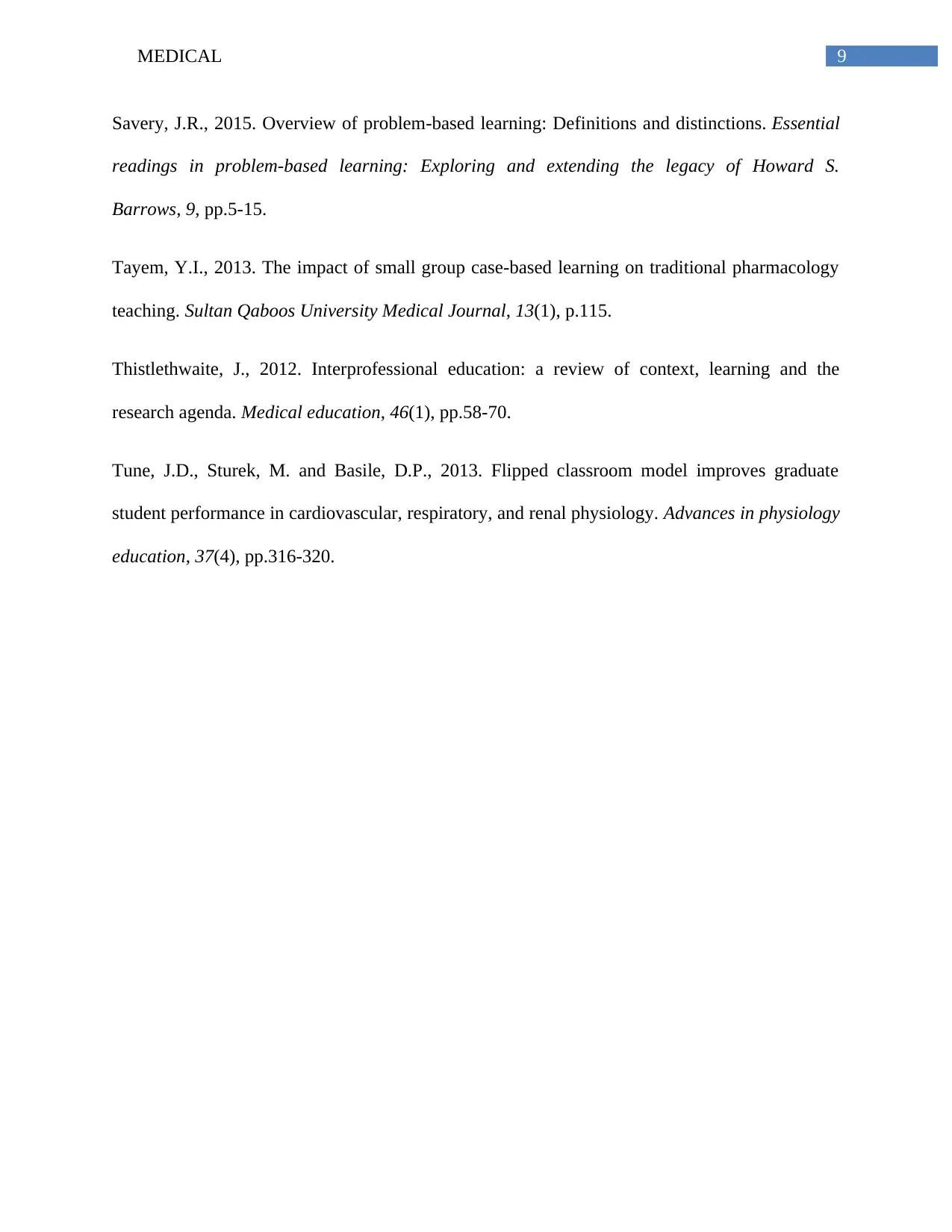
9MEDICAL
Savery, J.R., 2015. Overview of problem-based learning: Definitions and distinctions. Essential
readings in problem-based learning: Exploring and extending the legacy of Howard S.
Barrows, 9, pp.5-15.
Tayem, Y.I., 2013. The impact of small group case-based learning on traditional pharmacology
teaching. Sultan Qaboos University Medical Journal, 13(1), p.115.
Thistlethwaite, J., 2012. Interprofessional education: a review of context, learning and the
research agenda. Medical education, 46(1), pp.58-70.
Tune, J.D., Sturek, M. and Basile, D.P., 2013. Flipped classroom model improves graduate
student performance in cardiovascular, respiratory, and renal physiology. Advances in physiology
education, 37(4), pp.316-320.
Savery, J.R., 2015. Overview of problem-based learning: Definitions and distinctions. Essential
readings in problem-based learning: Exploring and extending the legacy of Howard S.
Barrows, 9, pp.5-15.
Tayem, Y.I., 2013. The impact of small group case-based learning on traditional pharmacology
teaching. Sultan Qaboos University Medical Journal, 13(1), p.115.
Thistlethwaite, J., 2012. Interprofessional education: a review of context, learning and the
research agenda. Medical education, 46(1), pp.58-70.
Tune, J.D., Sturek, M. and Basile, D.P., 2013. Flipped classroom model improves graduate
student performance in cardiovascular, respiratory, and renal physiology. Advances in physiology
education, 37(4), pp.316-320.
1 out of 10
Related Documents
Your All-in-One AI-Powered Toolkit for Academic Success.
+13062052269
info@desklib.com
Available 24*7 on WhatsApp / Email
![[object Object]](/_next/static/media/star-bottom.7253800d.svg)
Unlock your academic potential
Copyright © 2020–2025 A2Z Services. All Rights Reserved. Developed and managed by ZUCOL.



